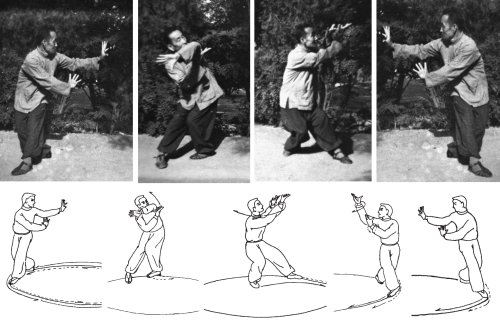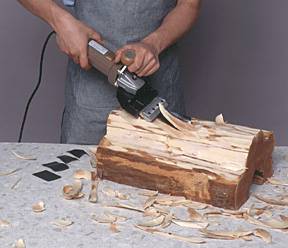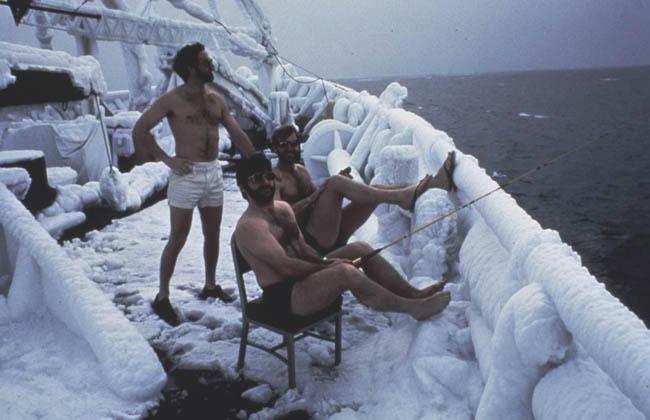Mish Mash
/_______

I love this picture series of Liu Fengcai doing Baguazhang.
In these pictures he is emphasizing polarity in his body created by the combination of "monkey doesn't want to go to school" and "effortlessly floating the head upward." The two forces create extraordinary external wrapping of the soft tissue around the torso and the backs of the legs-- this is evident in the shape of his hands. Sweet. (The artist's sketch underneath is an unnecessary distraction, but notice he added the drawing 4th from the left which breaks several baguazhang rules. The arrows are misleading too.)
____________
Only Comics and Dogs Wiggle their Head!
For all the hemming and hollering I’ve heard over the years about the importance of keeping the head upright as well as contrary opinions in favor of practicing dodging and ducking with the head, I am delighted to let everyone know that the controversy was created entirely from the denial of gongfu’s theatrical origins.
Here is a video of me doing an 8 part warm up that came from Kuo Lien-ying which I have been doing for 30 years. After reading Jo Riley's book Chinese Theater and the Actor in Performance. I've changed three of the movements slightly (I'll have to make a new video). I'm very sure that I've been doing the exercises slightly wrong for all these years because I was limited in my view and simply didn't understand the original instructions.
Number 2 in the series is for training the basic heroic stance and should be done with the chest lifted more than you see here.
Number 3 is the basic comic stance and should be done with the tailbone back, the belly out, the arms straighter, and the head lifted. In this position it is OK if the head wiggles because that's what comics and dogs do to show their lower statues. It's so much better this way.
Lastly the 8th stance, usually called "chin to toe," is used as a mind clearing exercise by performers back stage immediately before they perform. It should be done with the kidneys forward, not back as I've shown in the video. Thanks Jo, that tiny bit of information unlocked a lot of secrets for me. (Yes, there are secrets.)
__________
Disheveled and in disarray...
is a good description of all of my Daoist studies, as well as all my “progress” in martial arts. I have followed my teachers in trying to transmit brilliant structures, orders, and systemizations in my writings. However; the reality is a lopsided, languid, sometimes choppy, sometimes flowing, unwieldy beast.
Occasionally I pick up a comment saying I'm too organized. Reality doesn't fit in boxes. Thanks for pointing that out. All systemizations are also limitations. All stated orders are incomplete. The truth is always available in completely undifferentiated chaos (huntun), just waiting for you to stick your head in there and pull it out.
Occasionally I have received friendly comments here and on various forums which describe my thinking as mystical. While I realize it is silly of me to take umbrage at this, it does rub me the wrong way. I’m not personally interested in a mystical journey. I’m not declaring that everything I say is a concrete metaphor, yes, my metaphors are sometimes misty or even foggy; but I am not on a mystical journey. Sometimes looking in at something new or foreign from the outside creates a mystical feeling in the observer, that's fine, but please tell me if you think I’ve become rooted in anything less than what is absolutely real.
___________
Chinese Martial Arts are a treasure...
but they are a changing treasure. The Daodejing mentions three unchanging treasures, hold and preserve them!
The first is compassion. (We're talking predator drone, Buffy the Vampire Slayer, in the thick-of-it, compassion-- not moral platitudinous, bumper-sticker yoga compassion like, "Do no harm.")
The second is conservation. (No not greenness people! I’m (in the) black and I’m proud! Business is the most effective social mechanism for conservation ever-- cut your costs, improve your efficiency-- now let excess, laziness, misty eyed romantics, hysterical greenies, and inferior products and services die.)
The third is not imagining yourself to be at the center of the world. (Duh!)
The three treasures do not lend themselves to fame, or charisma, or even claims of authorship. Each person, or family, or community, or nation, or institution can find its own way to express these treasures. But it's not hard to see why one might be inspired to live like a hermit.
____________
Cold! Lively!
I love being outside this time of year! When the temperature drops the surface of my body cools down, but the inside stays hot. This is an ideal condition for cultivating the Daoist elixir practice (jindan) and martial arts in general. Why? Because jing and qi differentiate more easily. Our structure, the heavy stuff we are made of, jing, is easier to feel and therefore relax because it is cold on the surface. And our qi, the activity, the motion, the animation, is more obvious on the inside. It hums and vibrates. Explosive power is more available. In stillness the qi wiggles deeper into the bones, making whatever it is you practice irreversible. People who get lazy about their practice in the winter months miss out on the best season. THE BEST!
_________
Here are some websites I found interesting:
http://www.chinesewudangboxing.com/aboutus.htm
http://www.fathom.com/course/21701773/sessions.html
http://www.nexthomegeneration.com/Han_Dynasty#Eastern_Han
OK my home-slices, keep it real.

 The Uncarved Block is one of the primary metaphors for the concept/anti-concept known as wuwei. The Daodejing suggests that we be like an uncarved block of wood. The implication is that once a block of wood is fashioned into something, it loses it’s potential to be something else. Once we make a decision, it cuts off certain options. In other words, it is often good to wait. But the Daodejing isn’t telling us to be indecisive. It doesn’t say, “in difficult situations--waver!” It also doesn’t say be slow, like a tree; or “be inactive,” like a log or a stump. It says be like a partially processed block of wood. Since the Daodejing doesn’t give us any idea how big this block of wood might be, or what it might be for, we can speculate. Our block of wood could be carved into any sort of deity or icon, or perhaps a boat, a cabinet, a ladle, or a coffin. The Daodejing is using this metaphor to point to a process which takes place when we make something. It is not saying, “Don’t make stuff.” Sometimes a decision can position us for more possibilities, sometimes a decision can limit us. Is this better than that? Be comfortable with ambiguity, but have a few uncarved blocks hanging around in case you need them.
The Uncarved Block is one of the primary metaphors for the concept/anti-concept known as wuwei. The Daodejing suggests that we be like an uncarved block of wood. The implication is that once a block of wood is fashioned into something, it loses it’s potential to be something else. Once we make a decision, it cuts off certain options. In other words, it is often good to wait. But the Daodejing isn’t telling us to be indecisive. It doesn’t say, “in difficult situations--waver!” It also doesn’t say be slow, like a tree; or “be inactive,” like a log or a stump. It says be like a partially processed block of wood. Since the Daodejing doesn’t give us any idea how big this block of wood might be, or what it might be for, we can speculate. Our block of wood could be carved into any sort of deity or icon, or perhaps a boat, a cabinet, a ladle, or a coffin. The Daodejing is using this metaphor to point to a process which takes place when we make something. It is not saying, “Don’t make stuff.” Sometimes a decision can position us for more possibilities, sometimes a decision can limit us. Is this better than that? Be comfortable with ambiguity, but have a few uncarved blocks hanging around in case you need them.
 The moment I start writing a blog post, or you start reading one, the danger that we will lose sight of wuwei increases. Because reading and writing is a form of carving. The moment we put pen to paper we risk crossing over into the land of methods.
The moment I start writing a blog post, or you start reading one, the danger that we will lose sight of wuwei increases. Because reading and writing is a form of carving. The moment we put pen to paper we risk crossing over into the land of methods. Here is an article from the NYT about
Here is an article from the NYT about 
